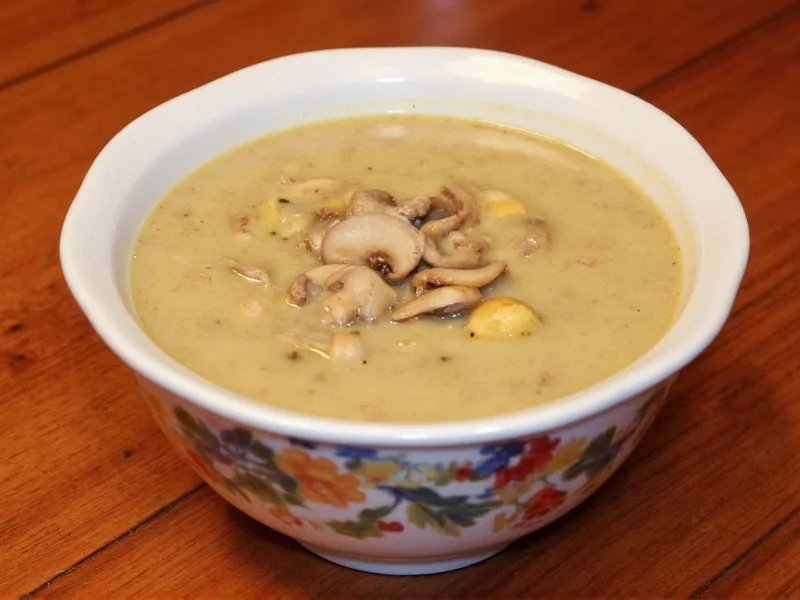Essential Ingredients for Perfect Mushroom Soup
Creating a flavorful mushroom soup begins with quality ingredients. While variations exist, these core components form the foundation of a rich, satisfying soup that showcases mushroom flavor without overpowering creaminess.
| Ingredient | Quantity | Why It Matters |
|---|---|---|
| Fresh mushrooms (cremini or button) | 1.5 lbs (680g) | Provides earthy base flavor; cremini offer deeper taste than button mushrooms |
| Yellow onion | 1 medium | Adds sweetness and depth when properly caramelized |
| Garlic cloves | 3 large | Essential aromatic that enhances mushroom flavor |
| Unsalted butter | 3 tablespoons | Superior flavor compared to oil for mushroom preparation |
| Vegetable or chicken broth | 4 cups (950ml) | Quality broth makes or breaks the final flavor profile |
| Dry sherry | 2 tablespoons | Secret ingredient that enhances umami without alcohol taste |
| Fresh thyme | 1 teaspoon | Complements mushrooms better than dried alternatives |
Equipment You'll Need
Having the right tools ensures smooth preparation when you're learning how to make mushroom soup from scratch. A heavy-bottomed pot prevents scorching during the critical sauté phase. An immersion blender creates the perfect texture without transferring hot liquid to a countertop blender. If you don't have an immersion blender, a standard blender works but requires careful handling of hot soup.
Step-by-Step Mushroom Soup Preparation
Follow these professional techniques for restaurant-quality mushroom soup at home. The key to exceptional flavor lies in proper mushroom preparation—a common mistake beginners make when attempting easy mushroom soup recipe for beginners.
1. Mushroom Preparation (Critical Step)
Clean mushrooms with a damp cloth rather than water to prevent absorption. Slice uniformly for even cooking. Many home cooks make the mistake of overcrowding the pan—this creates steam instead of the essential browning. Work in batches if necessary, using medium-high heat. Properly sautéed mushrooms should release their liquid, then brown deeply. This Maillard reaction creates complex flavors that define creamy homemade mushroom soup without cream.
2. Building Flavor Layers
After removing browned mushrooms, sauté diced onions until translucent (about 5 minutes). Add minced garlic and cook until fragrant (30 seconds). Return mushrooms to the pot, add sherry to deglaze, scraping up browned bits from the bottom. These fond particles contain concentrated flavor essential for mushroom soup recipe with depth of flavor.
3. Simmering and Blending
Add broth and thyme, bring to a gentle simmer for 20 minutes. Remove thyme sprigs, then blend until smooth using an immersion blender. For silky texture, strain through a fine-mesh sieve—a technique many homemade mushroom soup instructions omit but makes a noticeable difference.
Avoiding Common Mushroom Soup Mistakes
Even experienced cooks make these errors when preparing how to make mushroom soup that doesn't taste watery:
- Using water instead of quality broth—water-based soups lack depth. Homemade broth yields best results, but low-sodium store-bought works in a pinch
- Adding cream too early—dairy can curdle if added before proper cooling. For dairy-free creaminess, blend in 1/4 cup raw cashews with the soup
- Over-blending hot soup—always cool slightly before blending to prevent pressure buildup and potential burns
- Under-seasoning—mushrooms require more salt than expected. Season in layers: when sautéing, after adding broth, and before serving
Variations for Different Dietary Needs
Adapt this base recipe for various preferences while maintaining authentic mushroom flavor:
Vegan Mushroom Soup
Substitute butter with olive oil and use vegetable broth. For creaminess without dairy, blend in 1/2 avocado or 1/4 cup cooked white beans. This approach creates a satisfying vegan mushroom soup recipe that doesn't compromise flavor.
Wild Mushroom Variation
For more complex flavor, replace half the cremini mushrooms with a mix of wild varieties like chanterelles or morels. Add these delicate mushrooms during the last 5 minutes of cooking to preserve their unique textures—a technique essential for gourmet mushroom soup recipe for special occasions.
Storage and Reheating Guidelines
Proper storage maintains quality when making mushroom soup ahead of time for meal prep. Cool completely before transferring to airtight containers. Refrigerate for up to 4 days or freeze for 3 months. When reheating, add a splash of broth if the soup has thickened too much. Never boil reheated soup—gentle simmering preserves texture.
Perfect Pairings for Your Mushroom Soup
Elevate your homemade mushroom soup experience with these pairings:
- Crusty sourdough bread for dipping
- Simple arugula salad with lemon vinaigrette
- Roasted asparagus with parmesan
- For heartier meals, serve with grilled cheese sandwiches using gruyère cheese
Final Thoughts on Mastering Mushroom Soup
Creating exceptional mushroom soup requires attention to technique rather than expensive ingredients. The secret to how to make mushroom soup that impresses lies in proper mushroom preparation and layering flavors. Remember that patience during the sauté phase pays dividends in the final product. Whether you're preparing a quick weeknight meal or an elegant starter for guests, this foundational recipe adapts beautifully to your needs. With these techniques, you'll consistently produce restaurant-quality mushroom soup that highlights the earthy, umami-rich character of mushrooms without relying on excessive cream or artificial enhancers.











 浙公网安备
33010002000092号
浙公网安备
33010002000092号 浙B2-20120091-4
浙B2-20120091-4